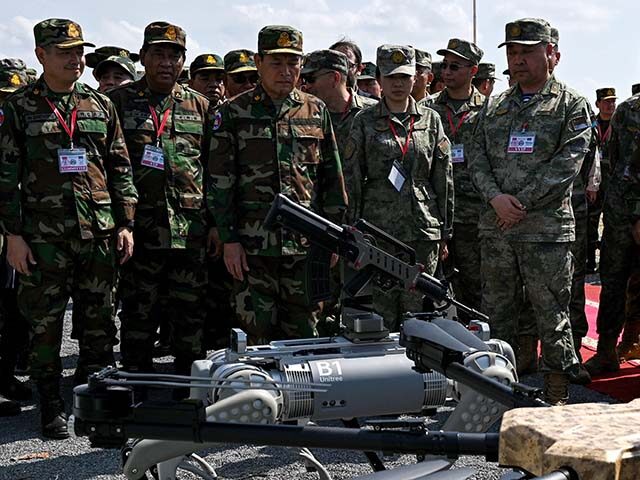China Showcases ‘Dogs of War’ Battle Robots in Cambodia Military Drills
 TANG CHHIN SOTHY/AFP via Getty Images
TANG CHHIN SOTHY/AFP via Getty Images
China’s largest-ever military drills with Cambodia on Thursday included a showcase performance by the literal dogs of war — a squad of robot dogs with automatic rifles mounted on their backs.
Both the People’s Liberation Army (PLA) of China and the U.S. military have experimented with militarizing the increasingly common “robodog” design. The South China Morning Post (SCMP) reported in March that the PLA saw an opportunity to pull ahead in killer robot research because American designers seemed more interested in using the robots for utility tasks on the battlefield, such as carrying supplies.
A Chinese research team published a study in February that found robodogs equipped with 7.62mm guns firing 750 rounds per minute could achieve respectable accuracy at ranges up to a hundred meters, equaling or exceeding the average accuracy of human riflemen.
The team thought quadruped platforms could become game-changing weapons for urban warfare, if the kinks in navigating dense and confusing city environments could be worked out. The paper suggested American planners were making a mistake by simply strapping guns to their military robodog test platforms, rather than customizing the weapon mounts to give the robot better accuracy and absorb recoil. Chinese researchers predicted they could use artificial intelligence (AI) to design a robot system that accounts for all the complexities of movement, recoil, and visibility on the battlefield.
“Chinese robotic dogs can now navigate stairs, perform acrobatic feats such as backflips, traverse garbage dumps or tropical rainforests, and maintain a continuous run for nearly four hours while carrying a 20kg load,” the SCMP noted.
American quadruped platforms appear to be somewhat more sophisticated for the time being, but China is catching up rapidly and its manufacturing advantages allow it to deliver field-ready units at prices far lower than U.S. companies. The industry-leading Boston Dynamics “Spot” robodog costs at least $70,000 per unit, while China’s model costs $3,000.
The robodog units China brought to Cambodia reportedly demonstrated only their walking capabilities, rather than their marksmanship. In addition to the robots, China sent about 760 military personnel to the drills in the central Kampong Chhnang province, plus 69 armored vehicles and tanks, and three warships for coastal maneuvers.
The 15-day “Golden Dragon” exercise formally kicked off on Thursday, with the costs to be covered by China. The Cambodian military also thanked the Chinese for “providing new equipment and helping to upgrade military facilities,” as the Associated Press put it.
Two of the warships dispatched by China were docked at the Ream naval base, which the U.S. fears could become a new strategic naval outpost for China.
The Cambodians responded to these concerns by insisting their constitution bans the deployment of foreign military forces on their soil, and the Chinese ships were merely “testing” the new pier China helped to construct at Ream.
Military analysts told Voice of America News (VOA) on Thursday that Cambodia’s denials were disingenuous, and China will almost certainly develop a permanent military presence at the Ream base.
“This would open another forward operating base for China to exert influence over the water off Vietnam’s southern coast and the Gulf of Thailand,” said University of New South Wales professor emeritus Carlyle Thayer.
The U.S. Embassy in Phnom Penh had a mild reaction to the Golden Dragon exercise, restating its respect for Cambodia’s sovereignty but urging it to choose a “diversity of military partners and transparency on activities that potentially impact the region.”
Source link

